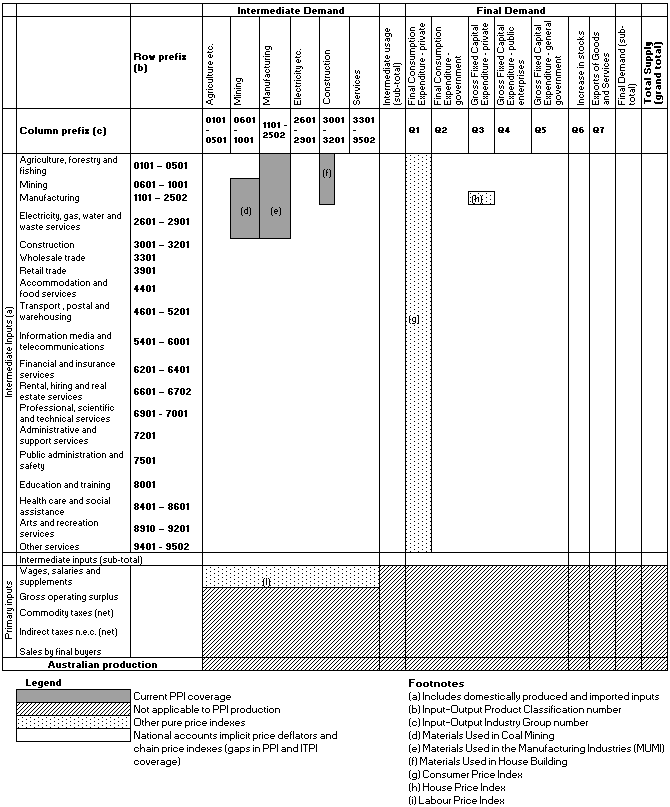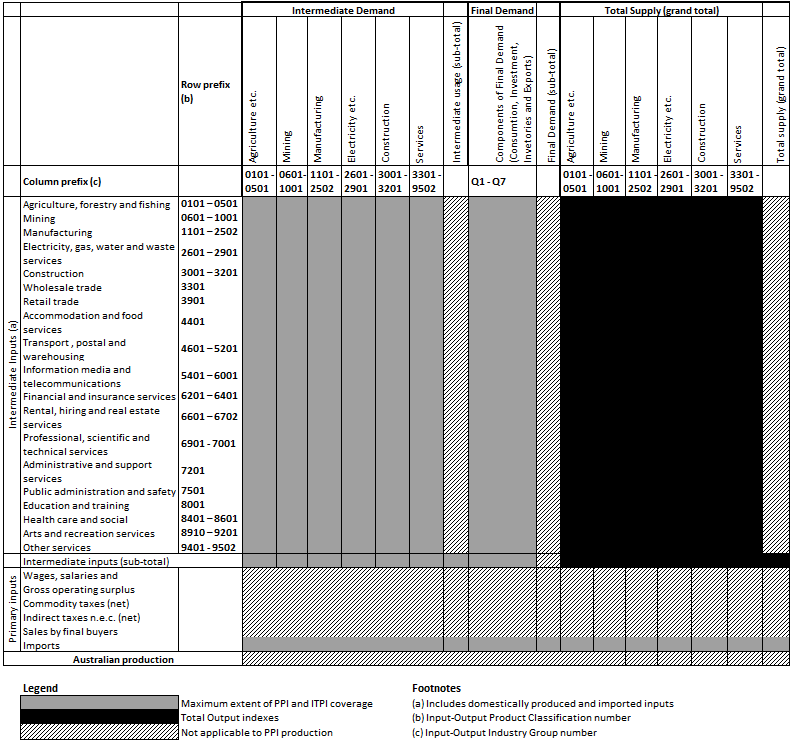 APPENDIX 2: PRICE INDEXES AND THE 2008 SYSTEM OF NATIONAL ACCOUNTS
APPENDIX 2: PRICE INDEXES AND THE 2008 SYSTEM OF NATIONAL ACCOUNTS
Introduction
Background
Overlaying I-O Tables with Price Indexes
INTRODUCTION
1 This appendix describes the relationship between the 2008 System of National Accounts (2008 SNA) Input–Output (I–O) framework and the Producer Price Indexes (PPIs) and International Trade Price Indexes (ITPIs). After providing some general definitions, the relationship is illustrated by overlaying the I–O tables with price indexes.
BACKGROUND
2 The National Accounts and Balance of Payments requirements for price indexes can be illustrated by reference to the 2008 SNA I–O framework. A 2008 SNA I–O framework has products in its rows, classified using the Input–Output Product Classification (IOPC), and has industries and final demand as its columns, classified using the Input–Output Industry Group (IOIG) classification. The I–O framework shows the flow of products through the production process of the Australian economy.
3 Inputs are the goods and services consumed by the process of production to produce outputs. Therefore, input price indexes measure the average price change of inputs used in production by a specified industry. Inputs are either sourced from a domestic production process or imported. An ABS example of an input price index is the price index of Materials Used in Manufacturing Industries (MUMI).
4 Input prices are valued at purchasers' prices, which is the amount paid by the purchaser, excluding any goods and services tax (GST) deductible by the purchaser, in order to take delivery of a unit of a good or service required by the purchaser. The purchaser’s price of a good includes transport charges paid separately by the purchaser to take delivery.
5 Outputs are the goods and services produced by an industry. Therefore output price indexes measure the average price change of produced goods and services that are sold on the domestic and export markets. An ABS example of an output price index is the price index of Articles Produced by the Manufacturing Industries (APMI).
6 Output prices are valued at basic prices, which are the amounts received by the producer from the purchaser for a unit of a good or service produced as output minus any tax payable, and plus any subsidy receivable, by the producer as a consequence of its production or sale. It excludes any transport charges invoiced separately.
7 An industrial classification is a way to organise production unit data. It provides a standard framework under which business units carrying out similar productive activities can be grouped, with each resultant group referred to as an industry. For the PPIs and ITPIs, products are assigned to the Australian and New Zealand Industrial Classification 2006 (ANZSIC 2006) on the basis of their use by production units classified to particular industries (input indexes) or the production of a particular industry (output indexes). The categories within ANZSIC 2006 are: division; sub-division; group; and class.
8 The National Accounts require price indexes (for deflation purposes) for each IOPC within the I–O framework. IOPCs concord to ANZSIC 2006. For more information on the IOPC and IOIG classifications see: Australian National Accounts: Input–Output Tables (Product Details) – Electronic Publication, 2007–08 (cat. no. 5215.0.55.001).
9 The source data for weighting the PPIs is the Australian National Accounts I–O tables.
10 The PPIs are weighted according to an IOPC's relative share of production (output) or use (input) in the I–O tables.
11 The supply section of the I–O table when valued at basic prices, is used to develop weights for the PPI output indexes. Examples of output PPIs are:
- APMI;
- Service industries;
- Output of the Construction Industry; and
- SOP indexes.
12 The use section of the I–O table when valued at purchasers’ prices, shows the use of products by industry for intermediate consumption (products used in an industry's production of output). These data are used as sources for the upper level weights for the input price indexes. For example, these data are used to for the MUMI indexes.
13 The ITPIs are important complements of domestic PPIs and imports and exports are included within the 2008 SNA I–O framework as primary inputs and final demand respectively. However, unlike the PPIs which are weighted according to the I–O tables, the price indexes for ITPIs are weighted from International Merchandise Trade data. The ITPIs are compiled on this basis to provide a set of internationally comparable statistics.
14 The current weighting basis for the IPI is derived from the average value of import items during 2010–11, while the EPI uses the average value of export items during 2009–10 and 2010–11. A longer period is used to calculate EPI weights because of the greater volatility associated with the value of export items.
15 Most countries, including Australia, use the Harmonized Commodity Description and Coding System (HS) to classify trade in goods, and to produce export and import price indexes. Historically, many countries used the Standard International Trade Classification (SITC) and produced export and import price indexes on both bases to compile longer timeseries. Australia uses the local revision of HS, the Australian Harmonized Export Commodity Classification for exports and Hamonized Tariff Items Statistical Codes for imports (see
Chapter 4 for ITPI development, including future changes to the weighting concepts).
OVERLAYING I-O TABLES WITH PRICE INDEXES
16 Diagrams 1 and 2, illustrate the PPIs and ITPIs and the I–O framework, highlighting that the current PPIs cover roughly only half of the economy with output indexes and very little of the economy with input indexes.
DIAGRAM 1 – OUTPUT INDEXES: CURRENT PPI AND ITPI COVERAGE
INPUT–OUTPUT FRAMEWORK AT BASIC PRICES

DIAGRAM 2 – INPUT INDEXES: CURRENT PRICE INDEX COVERAGE
INPUT–OUTPUT FRAMEWORK AT PURCHASERS' PRICES

17 Diagrams 3 and 4 illustrate the PPIs and ITPIs and the I–O framework, highlighting where aggregated and dissagragated price indexes would be available ideally for inputs and outputs of the Australian economy.
DIAGRAM 3 – OUTPUT INDEXES: IDEAL PPI AND ITPI COVERAGE
INPUT–OUTPUT FRAMEWORK AT BASIC PRICES
 DIAGRAM 4 – INPUT INDEX: IDEAL PPI AND ITPI COVERAGE
INPUT–OUTPUT FRAMEWORK AT PURCHASERS' PRICES
DIAGRAM 4 – INPUT INDEX: IDEAL PPI AND ITPI COVERAGE
INPUT–OUTPUT FRAMEWORK AT PURCHASERS' PRICES

 Print Page
Print Page
 Print All
Print All